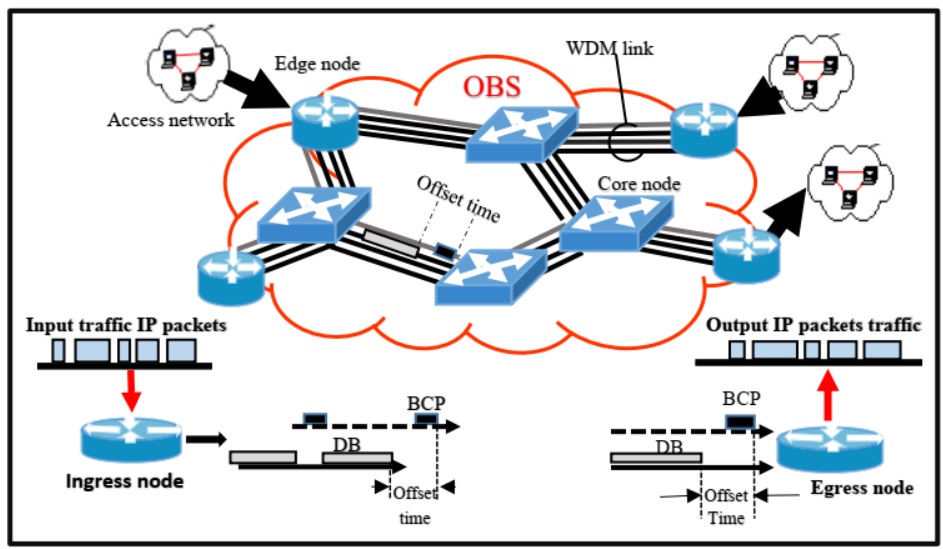Performance Comparison of JIT and JET Protocols on the OBS Networks
DOI:
https://doi.org/10.51173/jt.v4i4.751Keywords:
Optical Burst Switching (OBS), Contention resolution, Just-In-Time (JIT), Just-Enough-Time (JET), Deflection Routing (DR)Abstract
Over the past few years, internet traffic has been explosive growth due to users' need for more applications and services. All these developments on the internet need more bandwidth. The Optical Burst Switching (OBS) mechanism along with Wavelength-Division-Multiplexing (WDM) technology is very useful in meeting the high bandwidth requirements. However, the OBS network uses a one-way resource reservation mechanism, as well as it is a buffer lack at the intermediate (core) node. Therefore, the OBS network depends on contention resolution mechanisms to achieve acceptable levels of performance. In this paper, the Deflection Routing (DR) mechanism is used to overcome contention. The performance of the OBS network has been estimated by executing Just-In-Time (JIT) and Just-Enough-Time (JET) signaling reservation protocols with the DR. NCTUns-6.0 simulator was employed to verify the performance of the OBS network based on two metrics: throughput and packets dropped in the network. The results show that the bandwidth resources utilization in the OBS network with JET and DR (OBS-JET-DR) is better than in the OBS network with JIT and DR (OBS-JIT-DR). However, the average number of packets dropped in OBS-JET-DR is less than OBS-JIT-DR by 21%. In addition, the throughput of OBS-JET-DR has increased by 4% compared with OBS-JIT-DR.
Downloads
References
Majumdar AK. "Technology Developments, Research Challenges, and Advances for FSO Communication for Space/Aerial/Terrestrial/Underwater (SATU) Links". Laser Commun with Constell Satell UAVs, HAPs Balloon, pp 129–58, 2022.
Suresh A, R Kishorekumar, MS Kumar, K Elaiyaraja. "Assessing transmission excellence and flow detection based on Machine Learning". Opt Quantum Electron, Vol.54, pp 1–12, 2022.
Vanitha DV, D Sumitha, M Nila. "IMPact Of Burst Priority, Collisions, Feedback And Buffer Search In Obs NetworkS". IJRAR-International J Res Anal Rev, Vol.9, pp 179–85, 2022.
Nleya B. "A RWA framework for improved throughput in OBS networks". J Opt, Vol.51, pp 89–105, 2022.
Boobalan P. "A Unified Framework For Enhancing Qos Provisioning In Optical Burst Switching Networks", 2015.
Wang CC, XW Yao, WL Wang, JM Jornet. "Multi-Hop Deflection Routing Algorithm Based on Reinforcement Learning for Energy-Harvesting Nanonetworks". IEEE Trans Mob Comput, Vol.21, pp 211–25, 2022.
Gravett AS, MC du Plessis, TB Gibbon. "A distributed ant-based algorithm for routing and wavelength assignment in an optical burst switching flexible spectrum network with transmission impairments". Photonic Netw Commun, Vol.34, pp 375–95, 2017.
Dutta MK. A Comparative Study Among Different Signaling Schemes of Optical Burst Switching (OBS) Network for Real-Time Multimedia Applications. Adv. Intell. Syst. Comput., vol. 988, Springer; pp. 107–117, 2020.
A Gupta. "An efficient signaling framework based on multiple time slots for OBS networks". SOP Trans Signal Process, Vol.2, pp 7–16, 2015.
I. Saleh A. "QoS provisioning for Composite Burst Assembly with Burst Segmentation in Optical Burst Switching (OBS) Networks". Kirkuk Univ Journal-Scientific Stud, Vol.10, pp 28–41, 2015.
Duong PD, HQ Nguyen, TC Dang, VMN Vo. "Modeling of a controlled retransmission scheme for loss recovery in optical burst switching networks". ETRI J, Vol.44,pp 274–85, 2022.
Ekmekci D, A Huzber. "A Review of Enhancement Traditional Wide Band Networks by Using Enhanced WIMAX Technology". J Algebr Stat, Vol.13,pp 1096–107, 2022.
Solanska M, M Markovic, M Dado. "Resource reservation schemes for optical burst switching networks". Commun - Sci Lett Univ Žilina, Vol.18,pp 88–92, 2016.
Callegati F, D Careglio, LH Bonani, M Pickavet, J Solé-Pareta. "Why Optical Packet Switching failed and can Elastic Optical Networks take its place?". Opt Switch Netw, Vol.44, pp 100664, 2022.
Telesca G, I Ivanova-Stanik, R Zagórski, S Brezinsek, A Czarnecka, P Drewelow, et al. "High power neon seeded JET discharges Experiments and simulations". Nucl Mater Energy, Vol.12, pp 882–6, 2017.
Nhat Vo VM, V Hoa Le. "An approach of data analysis to improve scheduling efficiency in optical burst switched networks". Int J Commun Syst, pp e5242, 2022.
Sachdeva S, J Malhotra, M Kumar. "Contention resolution in dense WDM-PON networks by incorporating fiber temporal delay approach". Opt Quantum Electron, Vol.53, pp 1–11, 2021.
Khumalo P, B Nleya, A Mutsvangwa. "A controllable deflection routing and wavelength assignment algorithm in OBS networks". J Opt, Vol.48, pp 539–48, 2019.
Poorzare R, A Calveras, S Abedidarabad. "An improvement over TCP Vegas to enhance its performance in optical burst switching networks". Opt, Rev, Vol.28, pp 215–26, 2021.
Singh S, S Singh, B Kaur, A Singh. "Contention Avoidance Scheme Using Machine Learning Inspired Deflection Routing Algorithm in Optical Burst Switched Network". SSRN Electron J, Vol.2020, 2021.
A. Alimi I, R K. Patel, O Aboderin, A M. Abdalla, R A. Gbadamosi, N J. Muga, et al. "Network-on-Chip Topologies: Potentials, Technical Challenges, Recent Advances, and Research Direction". Network-on-Chip - Archit Optim Des Explore, 2022.

Downloads
Published
How to Cite
Issue
Section
License
Copyright (c) 2022 Alaa Jamal Abd, Mohammed Joudah Zaiter

This work is licensed under a Creative Commons Attribution 4.0 International License.
















